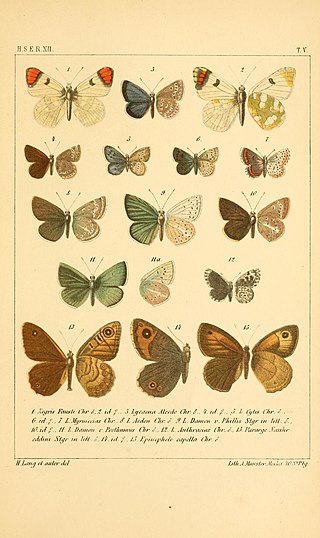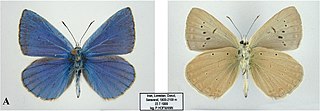
The chalkhill blue is a butterfly in the family Lycaenidae. It is a small butterfly that can be found throughout the Palearctic realm, where it occurs primarily in grasslands rich in chalk. Males have a pale blue colour, while females are brown. Both have chequered fringes around their wings.

Polyommatus is a genus of butterflies in the family Lycaenidae. Its species are found in the Palearctic realm.

Polyommatus eros, the Eros blue or common meadow blue, is a species of blue butterfly found in the Palearctic.

Polyommatus damon, the Damon blue, is a butterfly of the family Lycaenidae.

Polyommatus daphnis, the Meleager's blue, is a butterfly of the family Lycaenidae.

Ripart's anomalous blue is a butterfly in the family Lycaenidae.

Polyommatus (Plebicula) dorylas, the turquoise blue, is a butterfly of the family Lycaenidae. It is found in southern Europe, Asia Minor, the Ural Mountains, Caucasus and Transcaucasia. Its wingspan is 15–17 mm. The butterfly's common name comes from the dazzling bright blue colour of male's wings. The larvae feed on Anthyllis vulneraria. The butterfly flies from May to September in two generations. Habitats include flowery meadows in rocky areas at 500–2000 m.

Polyommatus thersites, the Chapman's blue, is a butterfly in the family Lycaenidae. It is found in southern Europe, Morocco, Lebanon, Asia Minor, Iran and across the Palearctic to Siberia and Tian Shan.
Polyommatus andronicus is a butterfly in the family Lycaenidae. It is found in north-eastern Greece and south-western Bulgaria, where it inhabits the mountain ranges Slavyanka and southern Pirin.
Polyommatus actinides is a butterfly of the family Lycaenidae. It was described by Otto Staudinger in 1886. It is found in central Asia.

Polyommatus aedon is a butterfly of the family Lycaenidae. It was described by Hugo Theodor Christoph in 1887. It is found in central Anatolia, Kurdistan province of Iran, the Caucasus and Elburz Mountains.
Polyommatus arasbarani, the Arasbaran anomalous blue, is a butterfly of the family Lycaenidae. It was described by Carbonell & Naderi in 2000. It is endemic of southern slope of the Meghri Mountains in Armenia and nearby Arasbaran Mountains in northern Iran. Armenia is inhabited by subspecies P. a. neglecta. It inhabits forests alternated with dry steppe-like areas at elevations of 1700–2000 m above sea level. The species is included in the Red Book of Animals of the Republic of Armenia as endangered EN B1a+B2a, although in the book it is still called with the invalid name - Agrodiaetus neglectus.

Polyommatus atlantica, the Atlas blue, is a butterfly in the family Lycaenidae. It was described by Henry John Elwes in 1905. It is found in North Africa.
Polyommatus damonides, the Damonides blue, is a butterfly of the family Lycaenidae. It was described by Otto Staudinger in 1899. It is endemic to the southern part of the Zangezur Mountains, where it is known in two populations. One is the vicinity of the town of Meghri in Armenia and another lives near the town of Ordubad in Nakhichevan.

Polyommatus karindus is a butterfly of the family Lycaenidae. It was described by Norman Denbigh Riley in 1921. It is only known from the Iranian Zagros Mountains. The habitat consists of dry slopes, gorges and plateaus with xerophyte or steppe vegetation, sometimes wooded areas from 1,800 up to 2,800 meters.
Polyommatus nephohiptamenos, or Higgins's anomalous blue, is a butterfly of the family Lycaenidae described by J. Brown and John G. Coutsis in 1978. It has an IUCN Red List status of near threatened.










